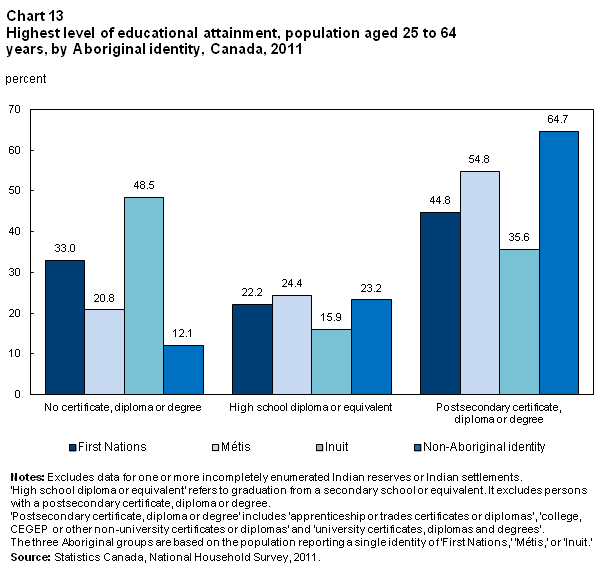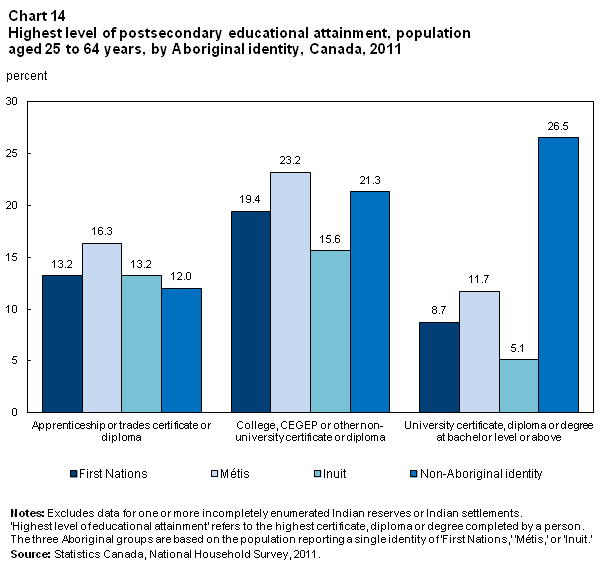Education
Archived Content
Information identified as archived is provided for reference, research or recordkeeping purposes. It is not subject to the Government of Canada Web Standards and has not been altered or updated since it was archived. Please "contact us" to request a format other than those available.
- Highest certificate, diploma or degree
- Postsecondary educational attainment
- Barriers to further education or training
- Literacy and numeracy
Highest certificate, diploma, or degree

Almost half of Aboriginal people reported they had a postsecondary qualification
In 2011, almost half (48%) of Aboriginal people aged 25 to 64 reported they had a postsecondary qualification. By comparison, about two thirds (65%) of non-Aboriginal people in the same age group had a postsecondary qualification, a difference of 17 percentage points.
Further, 45% of First Nations people aged 25 to 64 years had postsecondary qualifications, compared to 55% of Métis and 36% of Inuit in the same age group.
There was also a difference in the proportion of Aboriginal and non-Aboriginal people with 'no certificate, diploma or degree'. Among Aboriginal people aged 25 to 64, 29% had 'no certificate, diploma or degree' while the proportion of non-Aboriginal people in the same age group with the same level of education was 12%.
The proportion of Aboriginal people aged 25 to 64 with a high school diploma or equivalent as their highest level of educational attainment was 23%, the same proportion as observed for the non-Aboriginal population.
For additional information on education attainment, see 2011 National Household Survey: Data tables.
Postsecondary educational attainment

Aboriginal people more likely to have trades and college certificates than university degrees
Of those with First Nations identity aged 25 to 64 years, 45% had postsecondary qualifications: 13% had a trades certificate; 19% had a college diploma; and 9% had a university degree.
Over half (55%) of Métis in the same age group had postsecondary qualifications: 16% had a trades certificate; 23% had a college diploma; 4% a university certificate or diploma below the bachelor level; and 12% had a university degree. These are the highest proportions among the three Aboriginal groups (First Nations people, Métis and Inuit).
More than one-third (36%) of Inuit aged 25 to 64 had postsecondary qualifications: 13% had a trades certificate; 16% had a college diploma; 2% had a university certificate or diploma below the bachelor level; and 5% had a university degree.
For additional information on education attainment, see The educational attainment of Aboriginal peoples in Canada.
Barriers to further education or training
| Off-reserve First Nations people | Métis | Inuit | ||||
|---|---|---|---|---|---|---|
| completersNote † | leavers | completersNote † | leavers | completersNote † | leavers | |
| percent | ||||||
| Time constraints | 24 | 38Note * | 21 | 48Note * | 26 | 39Note * |
| Courses do not match needs | 19 | 26Note * | 18 | 30Note * | 27 | 27 |
| Lack of confidence/preparedness | 20 | 42Note * | 19 | 46Note * | 22 | 32Note * |
| Not a personal priority | 25 | 45Note * | 24 | 41Note * | 27 | 43Note * |
| Cost | 34 | 42Note * | 37 | 52Note * | 18 | 19 |
| Personal/family responsibilities | 31 | 50Note * | 24 | 46Note * | 37 | 52Note * |
| Personal health | 10 | 21Note * | 6 | 13Note * | 7 | 12 |
Percentages do not add up to 100% because respondents could choose more than one answer. Source: Statistics Canada, Aboriginal Peoples Survey, 2012. |
||||||
More barriers to education or training among high school leavers than completers
Leavers were more likely than completers to report that they lacked the confidence or felt unprepared to further their schooling. For example, among First Nations people living off reserve aged 18 to 44 years 42% of leavers identified this as a barrier, compared with 20% of completers. Leavers among this group were also more likely than completers to report that furthering their education was not a personal priority (45% versus 25%).
Leavers were more likely than completers to report that time constraints (too busy, no time to study) kept them from taking further education or training. Leavers were also more likely than completers to report that the courses available did not match their needs. Financial considerations usually play a role in continuing education. Leavers were more likely than completers to report costs were a barrier. For example, among Métis aged 18 to 44 years 52% of leavers identified this as a barrier, compared with 37% of completers.
Many Inuit reported that personal or family responsibilities kept them from further education.
For additional information, see The Education and Employment Experiences of First Nations People Living Off Reserve, Inuit, and Métis: Selected Findings from the 2012 Aboriginal Peoples Survey.
Literacy and numeracy
| Aboriginal identity population | Non-Aboriginal identity population | Aboriginal identity population | Non-Aboriginal identity population | |
|---|---|---|---|---|
| Literacy score | Numeracy score | |||
| Canada | 260 | 274 | 244 | 266 |
| Ontario | 269 | 276 | 252 | 267 |
| Manitoba | 259 | 276 | 245 | 267 |
| Saskatchewan | 248 | 274 | 232 | 266 |
| British Columbia | 266 | 275 | 250 | 267 |
| Yukon | 242 | 288 | 224 | 274 |
| Northwest Territories | 229 | 280 | 210 | 271 |
| Nunavut | 207 | 290 | 187 | 279 |
| Notes: Aboriginal peoples surveyed in the Programme for the International Assessment of Adult Competencies (PIAAC) are composed of First Nations people living off reserve (48%), Métis (44%), and Inuit (5%). In PIAAC, oversamples of Aboriginal people were drawn in Ontario, Manitoba, Saskatchewan, British Columbia (only for those living off reserve in large urban population centres), Yukon, Northwest Territories and Nunavut. The results were compiled to provide a picture of their skill levels in literacy, numeracy and problem solving in technology-rich environments (PS-TRE), enabling more detailed analysis of the proficiency of these populations in the seven provinces and territories. Source: Statistics Canada, International Survey of Adults, Programme for the International Assessment of Adult Competencies, 2012. |
||||
Aboriginal people have lower literacy and numeracy scores than their non-Aboriginal counterparts
The Aboriginal population across Canada scored an average of 260 in literacy, which was lower than the average score of 274 for the non-Aboriginal population. For the seven provinces and territories that were oversampled, this difference also held true, but the magnitude of the difference varied. In Ontario and British Columbia, it was 7 and 9 points lower respectively; in the three territories, it was more than 40 points lower.
The average numeracy score for the Aboriginal population across Canada was 244, whereas the score for the non-Aboriginal population was 266. In the seven provinces and territories oversampled, Aboriginal population scores were lower than their non-Aboriginal counterparts, but these differences varied considerably. Among the four provinces, the difference ranged from 15 points lower in Ontario to 35 lower in Saskatchewan; in the territories, the difference was more than 50 points lower. Within each province and territory, the difference was slightly larger for numeracy than for literacy.
For additional information, see Skills in Canada: First Results from the Programme for the International Assessment of Adult Competencies (PIAAC).
- Date modified:
